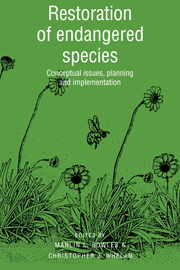Book contents
- Frontmatter
- Contents
- List of contributors
- Foreword
- Acknowledgments
- I Conceptual issues in restoration ecology
- II Restoration planning
- 6 Impacts of biological invasions on the management and recovery of rare plants in Haleakala National Park, Maui, Hawaii
- 7 Disturbance-dependent persistence of rare plants: anthropogenic impacts and restoration implications
- 8 A metapopulation approach to Pitcher's thistle (Cirsium pitcheri) recovery in southern Lake Michigan dunes
- 9 Restoration of woodland caribou to the Lake Superior region
- III Implemented restorations
- IV Synthesis and future directions: biology, politics and reality
- Taxonomic Index
- Subject Index
8 - A metapopulation approach to Pitcher's thistle (Cirsium pitcheri) recovery in southern Lake Michigan dunes
Published online by Cambridge University Press: 27 January 2010
- Frontmatter
- Contents
- List of contributors
- Foreword
- Acknowledgments
- I Conceptual issues in restoration ecology
- II Restoration planning
- 6 Impacts of biological invasions on the management and recovery of rare plants in Haleakala National Park, Maui, Hawaii
- 7 Disturbance-dependent persistence of rare plants: anthropogenic impacts and restoration implications
- 8 A metapopulation approach to Pitcher's thistle (Cirsium pitcheri) recovery in southern Lake Michigan dunes
- 9 Restoration of woodland caribou to the Lake Superior region
- III Implemented restorations
- IV Synthesis and future directions: biology, politics and reality
- Taxonomic Index
- Subject Index
Summary
Introduction
Successful recovery planning for a rare species relies upon knowledge of its life history and ecology, as well as an understanding of its habitat requirements and disturbance regime (Gilpin & Soulé 1986, Lande 1988a). Species that depend upon early-successional or transient habitats in landscape mosaics present unique recovery challenges (Menges 1990). They require perpetuation of multiple populations within a shifting mosaic of local habitats. Recovery plans for these species must be formulated from an understanding of population demography within the context of community and landscape dynamics. Processes that maintain landscape mosaics must be given long-term protection if recovery is to succeed.
Pitcher's thistle, Cirsium pitcheri (Torr.) T. and G., is listed as threatened in the United States and Canada (Harrison 1988). This monocarpic plant is endemic to the western Great Lakes sand dunes. It is an early-successional species that colonizes open patches in dynamic dune landscapes (Pavlovic et al. 1993). Its recovery depends upon the perpetuation of interacting mosaics of populations, or metapopulations, in Great Lakes dune systems. The concept of metapopulation dynamics (Levins 1970, den Boer 1981, Gilpin 1987, Goodman 1987a, Gilpin & Hanski 1991) is useful for understanding Cirsium pitcheri ecology and management options. It describes species persistence in environments where the probability of local extinction is high, and has applications to species recovery and reserve design (e.g., Shaffer 1981, Gilpin & Soulé 1986, Goodman 1987b, Lande 1988b, Menges 1990, Murphy, Freas & Weiss 1990).
- Type
- Chapter
- Information
- Restoration of Endangered SpeciesConceptual Issues, Planning and Implementation, pp. 194 - 218Publisher: Cambridge University PressPrint publication year: 1994
- 13
- Cited by



